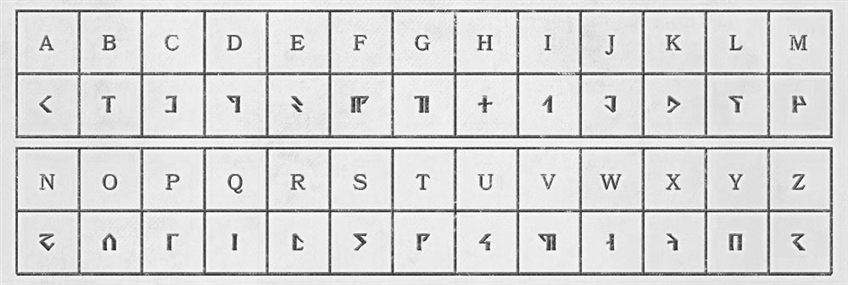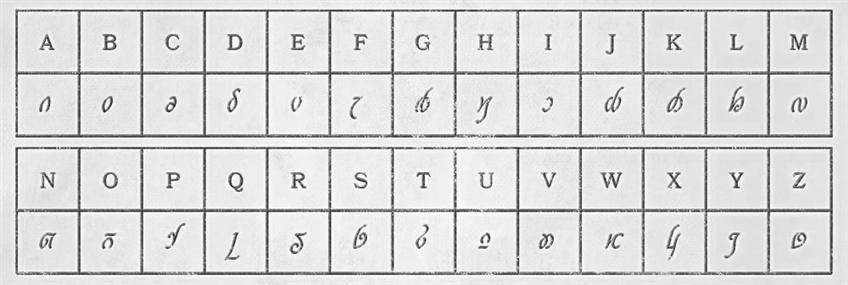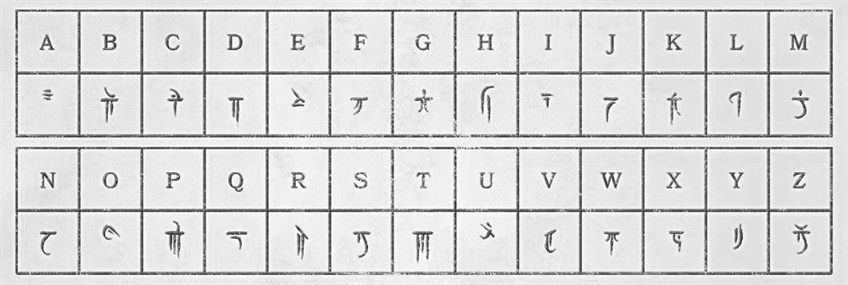Last Updated on January 22, 2023
One of the first choices you make when creating your new D&D character is which languages they speak.
There are more than 60 languages found throughout the full extent of D&D 5e including 8 Common and 8 Exotic in the Players Handbook, over 50 more in expansions and settings, and another 30 creature languages. Player characters all know at least two languages but may amass many more throughout their adventures.
Languages are a frequently overlooked or ignored element of D&D, largely thanks to widespread use of Common. However, languages have a ton of potential for interesting and engaging gameplay that adds real depth and verisimilitude to a D&D campaign.
This guide will tell you everything you need to know about the languages spoken throughout the many worlds of D&D, and how to use them in your game.
Standard and Exotic Languages Table
There are eight standard languages and eight exotic languages found in the Player’s Handbook, as well as several dialects. Setting specific books like Sword Coast Adventurer’s Guide, Eberron: Rising From the Last War and Guildmaster’s Guide to Ravnica add more standard and exotic languages to D&D 5e.
Standard Languages in DnD 5e
Common
Common is the lingua franca of the Forgotten Realms and of most D&D settings. (It’s worth noting that one setting’s common may not be the same as another’s–which could become relevant if you’re playing a universe-hopping Spelljammer campaign). Common is predominantly spoken by humans but most characters of any race will be fluent in Common. This is the language you speak in most roleplay situations.
Dwarvish, Elvish, Gnomish, and Halfling
These languages are commonly spoken in the human villages and towns of the Forgotten Realms. They’re spoken by dwarves, elves, gnomes, and halflings respectively. These races also have their own settlements where their own languages are more dominant. Even in those settlements though, you’ll often be able to get by with Common.
With these languages, it’s important to create your own opportunities to use them. DMs will often assume that, because all present characters speak common, languages aren’t a factor and can be ignored. As a player though, you can still use your languages to add flavor to roleplay and gain gameplay benefits.
Giant, Goblin, and Orc
These languages are rarer in human settlements. The goblinoids and orcs of the Forgotten Realms are evil-aligned so they’re not generally welcome in human settlements.
Giant is spoken by races who wouldn’t ordinarily choose to visit human settlements. Elemental giants have little interest in the affairs of humans and are simply too large for human settlements, although they may occasionally make an appearance. Trolls, ogres, and ettins are all evil aligned and typically unwelcome. Forest-loving firbolgs and mountain-dwelling goliaths are unlikely to spend time in human settlements unless they’re left without a choice.
Giant, Goblin, and Orc are all languages that you’ll most frequently encounter in the wilds. Most of their speakers will usually be hostile to you. This presents its own set of opportunities but your usage of these languages will be very different from dwarvish or elvish.
Exotic languages
Exotic languages are a risk to take in character creation. If you pick the wrong language then you may never get an opportunity to use it. In many campaigns, for example, celestials simply don’t ever make an appearance so learning Celestial may be a complete waste.
With these languages, it’s a good idea to ask your DM which they expect to be most useful. Infernal may be useless unless either you’re playing a campaign in hell or you expect to meet a lot of teiflings. If your party never traverses the Underdark then Undercommon will be totally useless to you. On the other hand, Undercommon might be absolutely essential if a large portion of the campaign takes place in the Underdark.
The one exception to this is Draconic. The game is called “Dungeons and Dragons”. Dragons are some of the most exciting and evocative creatures in the game and often players will feel cheated if they play an entire campaign without ever seeing a dragon. Even in campaigns that don’t focus on dragons, it’s not unusual for the final BBEG to be an ancient dragon. It’s a safe bet that you’ll at some point run into Draconic-speakers and those characters will often be some of the most important NPCs in the game.
Creature Languages
There are many languages — written, spoken, or only used to communicate telepathically or nonverbally — spoken by various races of creature and monster in D&D. Typically, the only way to understand or speak these languages is through spells like Comprehend Languages or Tongues.
However, the Ranger class’ Favored Enemy ability lets them learn one of the following languages depending on their choice of foe.
Different Scripts
Many languages in the real world share a basic alphabet, whether because they share a common linguistic ancestry (like Russian, Bulgarian, Khazak, and Serbian all sharing the cyrillic alphabet) or because of more purposeful changes (like the transition of Vietnamese from Chinese characters to a modified version of the latin alphabet under French colonial rule) in the more recent past.
In D&D, like real life, many languages share an alphabet or script, the most common of which being Dwarvish, although Common and Elvish also frequently form the basis of other languages.
Dwarvish Alphabet

Elvish Alphabet

Draconic Alphabet

How does my character get their languages?
There’s one customization option that grants languages to all D&D characters: their race. When you choose your character’s race, you also gain a number of languages. Most races learn two, but there are exceptions. A few, like half-elves and firbolgs, learn three.
For most races, you don’t get a choice about which languages you learn. Dwarves, for example, learn Common and Dwarvish. Some do get to choose though. Humans and half-elves both get to choose one of their languages from the full list.
All races learn Common as one of their languages. This means your party will always have one language in common and will be able to communicate with one another, regardless of which races you choose to play.
Backgrounds – how do I get more languages in character creation?
In addition to their race and class, all characters also have a background. This gives your characters bonuses, extra features, or items depending on who they were before they took up a life of adventuring. These backgrounds are often named after a profession that your character might have had. For example, Soldier and Sailor are each background options.
Many backgrounds grant your character one or more languages. Guild Artisans and Nobles each gain one additional language. The Sage background is particularly notable because it grants two languages. A half-elf sage is able to start the game knowing five different languages.
Can I learn a new language, after character creation has finished?
In campaigns with extended periods of downtime between adventures, you might be able to learn a new language.
The ability to learn a new language depends a lot on your DM. Learning a language takes time and not all DMs include extended periods of downtime in their games – many D&D games are just non-stop action. Learning a new language also requires that you find a willing instructor. While it might be easy to find an instructor to teach you dwarvish or elvish, learning Deep Speech or Abyssal may be trickier.
Once you’ve found your instructor, learning a new language takes ten weeks minus a number of weeks equal to your character’s intelligence modifier. There’s also a 10% chance, every ten weeks of training, that a complication will arise. Complications are determined randomly by rolling on the table on page 134 of Xanathar’s Guide to Everything.
There are also separate rules for language learning on page 187 of the Player’s Handbook. These are less extensive and have been superseded by the rules in Xanathar’s Guide to Everything but some DMs may prefer them.
What are the best languages to pick?
D&D campaigns take place in very different settings and have very different focuses. The most useful languages in your game may vary based on your DM and the campaign’s focus.
If you expect the campaign to focus on a certain group of creatures, who share a specific language, then that language will probably be more useful in your game. For example, the officially published campaign Storm King’s Thunder focuses on the affairs of giants. Players can expect to spend a lot of their time talking to giants and fighting both against and beside them. Storm King’s Thunder presents a ton of great opportunities to use the Giant language.
Descent into Avernus is another great example of how the setting of a campaign influences which languages are most useful. Most of the campaign takes place in Avernus – a fiery hellscape, ruled and populated by devils. Infernal is an enormously valuable language for that setting because you can expect to interact with many of its speakers.
Some languages are more or less useful depending on the level of your campaign. Low-level play often involves fighting goblins and orcs so the languages, Goblin and Orc, may have more utility at lower levels. Deep Speech or Abyssal, meanwhile, might not be very useful until you reach quite high-level play.
The languages of the common races, those being Dwarvish, Elvish, Halfling, etc., may be less useful than you’d expect. Most campaigns feature plenty of those languages’ speakers but those characters generally all speak common. Even if you don’t know Elvish or Dwarvish, you’ll still be able to communicate with elves and dwarves.
NPCs of the common races are more likely to want the players to understand them so they’ll freely communicate in Common. These languages can still be useful though. If you’re spying on a group of elves then it’s useful to understand overheard speech between elves or to be able to read Elvish documents.
Your DM might also give some bonuses if you’re able to address NPCs in their own language, even if they speak common.
Characters that are ordinarily hostile to the party, like goblins and orcs, might be less willing to speak common. Knowing these characters’ languages could be useful because it allows you to understand the enemies’ internal communication and coordination in combat.
How do I find opportunities to use languages?
Many DMs don’t place much focus on language in their games. Heavy use of languages in roleplay can create situations where some party members can’t react or respond to whatever is happening because their characters simply don’t understand what’s being said. Many DMs, to avoid alienating players, will avoid languages entirely and have all NPCs interact with the party in common.
More pragmatically, languages are an additional layer of complexity for the DM to track and some DMs may prefer to avoid the potential confusion that they bring.
You can still get plenty of use out of your languages though. You just need to proactively look for opportunities to use them.
You can greet an NPC in their own language, even if you then continue to speak in common afterward. Signaling to the NPC that your character knows their language might lead to a more positive relationship with that NPC. For example, if you know Dwarvish and you’re interacting with a dwarf merchant then you might say: “I introduce myself with a friendly, colloquial, Dwarvish greeting. Then I switch to Common so everyone can understand.” This may lead to friendlier relations with the merchant, who might offer you lower prices or interesting rumors.
You can also look for opportunities to gain information when you’re in situations where you might overhear a language that you know. If you’re fighting a group of orc mercenaries then you could ask your DM: “I listen out for the orcs talking in Orc. Can I hear them coordinating their attack? And, if so, do I gain any tactical insights?” This may give you useful tactical information that will you and your party plan how to respond. Your DM may even grant you bonuses to rolls in some situations.
Common questions about D&D languages
What languages are there in D&D?
D&D has sixteen languages in its base setting: Common, Dwarvish, Elvish, Giant, Gnomish, Goblin, Halfling, Orc, Abyssal, Celestial, Deep Speech, Draconic, Infernal, Primordial, Sylvan, and Undercommon. Some of these languages have multiple dialects. For example, Primordial has four different dialects: Auran, Aquan, Ignan, and Terran. These dialects can all be understood by any speaker of the language.
Other settings, like Eberron, Ravnica, and Ravenloft, have multiple languages that are unique to them, and many monstrous races and intelligent animals speak languages of their own that a ranger can learn as part of their favored enemy ability.
How many languages are there in D&D?
There are sixteen languages in D&D. Eight of these are standard languages and eight are exotic. Some of these languages are further separated into dialects but these aren’t separate languages and speakers of the same language can understand each other even if their dialects are different. If you include languages outside the core game, that number grows to just under 30. If you include creature languages like gnoll, slaad, and yeti, that figure exceeds 60.
What language should I choose for D&D?
It depends on the campaign! Standard languages like Elvish and Dwarvish are useful in most campaigns, so they’re safe bets. The most useful language though will be the language of whichever creatures you encounter a lot. This varies from campaign to campaign so, if you’re not sure, ask your DM which languages they expect to be most useful.
What are the most common languages in D&D?
Common is spoken by most inhabitants of the Forgotten Realms and is the most commonly used language in D&D. The other standard languages are all widespread in usage and you’ll often encounter characters who speak Dwarvish, Elvish, Halfling, and other standard languages.
Exotic languages are rarer for players to encounter but their use is widespread within their spheres. For example, Sylvan is widely spoken in the feywild but is very unusual to encounter elsewhere.
Rich is an avid D&D player and DM. He has been playing since the Advanced Dungeons & Dragons 1st and 2nd editions. He has run campaigns of various editions with family and friends for over 20 years. Playing DnD 5th Edition in person at local game stores and online with VTT’s over the past 10 years has provided a consistent connection to how the game has grown. He strongly believes in understanding the source material, but catering the games to your individual players. Feel free to ask anything in the comments or drop him an email: [email protected].
